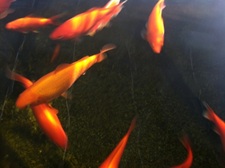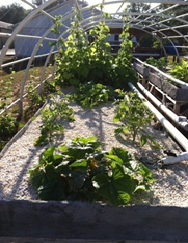Imagine that you have the ability to walk to an exterior building, a greenhouse, or even your basement and harvest a few pounds of fish. Right after you pull the fish out of the tank you walk a few steps away and harvest several types of lettuce, a cucumber and some cherry tomatoes. Life would be grand, right?
Let’s also say that you are able to raise the fish, Tilapia, and the vegetables in the  same system and in fact, the water that the fish swim in is used to feed and water the vegetables and that medium in which the vegetables live (which is not dirt) and the vegetables themselves clean the water that is sent back for the fish to swim in. What I’ve just described not only exists but you can build it yourself, and since it is a closed system you can set one up just about anywhere.
same system and in fact, the water that the fish swim in is used to feed and water the vegetables and that medium in which the vegetables live (which is not dirt) and the vegetables themselves clean the water that is sent back for the fish to swim in. What I’ve just described not only exists but you can build it yourself, and since it is a closed system you can set one up just about anywhere.
An aquaponics system is a merging of two agricultural sciences; AQUAculture, the raising of fish or other aquatic life in a closed environment and hydroPONICS, which as many of you know is raising plants without soil. It is usually configured with a tank for raising fish and other containers that are filled with some type of medium like pea gravel which is used to support the plants and more importantly it gives a place for the nitrifying bacteria that clean the water to live. Often a sump tank is also included in the system into which the water from the grow bins drain.
 My large system, the one in which I am raising edible fish and vegetables, has a sump. A medium sized continuous flow pond pump lifts the water from the sump to the fish tank. The water in the fish tank gravity flows from the fish tank into the grow bin system and fills the grow bins exposing the highly ammoniated water to the hungry nitrifying bacteria who begin to convert the ammonia to nitrogen. The water fills the grow bin until it triggers an Affnan siphon which creates a vacuum in the siphon and sucks much of the water from the grow bin and sends the now cleaned water back to the sump where the process starts over again. The process of siphoning, the travel through the piping, and the spilling back into the sump also aerate the water supporting the fish’s oxygen needs.
My large system, the one in which I am raising edible fish and vegetables, has a sump. A medium sized continuous flow pond pump lifts the water from the sump to the fish tank. The water in the fish tank gravity flows from the fish tank into the grow bin system and fills the grow bins exposing the highly ammoniated water to the hungry nitrifying bacteria who begin to convert the ammonia to nitrogen. The water fills the grow bin until it triggers an Affnan siphon which creates a vacuum in the siphon and sucks much of the water from the grow bin and sends the now cleaned water back to the sump where the process starts over again. The process of siphoning, the travel through the piping, and the spilling back into the sump also aerate the water supporting the fish’s oxygen needs.
Aquaponics systems recycle about 80% more water than that of traditional irrigation methods and, depending on the configuration, use very little electricity. I have built several systems from a desktop model that sat on my desk, to a system that sits on 1800 square feet with a greenhouse, and each of these systems functioned on one pump the size of which was selected to fit the system’s size.
As I have already said you can sit one up just about anywhere depending on size and the types of plants you intend to raise. There might be some challenges involved depending on your decisions; for instance if you wanted to place a system off grade or in a second story or an attic, so depending on its size, you would need to be aware of supporting structure for not only the weight of the tanks and containers but also the water and grow medium in the system.
Another challenge will be light for the plants. If you want a purely ornamental system for inside your home then you could choose Goldfish and low light house plants, or raise Tilapia and use house plants since the fish aren’t that concerned with the light. If you chose to raise edible fish and plants inside then you would necessarily need a grow light system for proper plant health but ask any basement marijuana grower and you will be told that it is completely doable!
There are a few things that I have learned from the several years that I have been building and maintaining aquaponics systems that I should pass on. First, use a fish that research has shown works well in a closed aquaculture system. Tilapia is one of these and also easily breeds in captivity making the system even more sustainable. There are other fish of course but to increase you’re the probability of success don’t experiment for your first try. I lost a couple hundred catfish before I understood that my oxygen levels were just not high enough to raise catfish.
The second thing you need to know is much like the first. Though someone might be able to raise any fruit or vegetable in an aquaponics system it is highly unlikely that a novice will be able to and, in my experience, unwise to try. There are just some vegetables that thrive in the aquaponics environment, some that can get by with a little help and some that take a bit of coaxing.
 Generally speaking, green leafy vegetables are a no-brainer for aquaponics. Lettuce (most types), for instance thrive on consistent water and high nitrogen levels as do cabbage, collards, broccoli and many of the other Cole crops. Herbs like Basil seem to grow well. Cucumbers also seem to thrive within the same environment and to some extent other melons. There might be many more vegetables that do well with no help but if you plant these that I have mentioned you are guaranteed some success.
Generally speaking, green leafy vegetables are a no-brainer for aquaponics. Lettuce (most types), for instance thrive on consistent water and high nitrogen levels as do cabbage, collards, broccoli and many of the other Cole crops. Herbs like Basil seem to grow well. Cucumbers also seem to thrive within the same environment and to some extent other melons. There might be many more vegetables that do well with no help but if you plant these that I have mentioned you are guaranteed some success.
A couple of years ago I experimented with a thing that we eventually called a ”tea-bag” which was nothing more than a mixture of organic potting soils and amendments containing low levels of plant nutrients other than nitrogen. We placed this dirt in a cotton pillow case and submerged it in the sump. With this addition we were able to grow cherry tomatoes extremely well, as well as some yellow squash.
All I’m saying is that if you’re planning to grow Bass and Bell peppers you might want to try something other than aquaponics, or be prepared for a significant learning curve!
When I started my journey into aquaponics there was very little information for the common man about this science but now the Internet is saturated with YouTube videos and articles. Do a little research then give it a try. Maybe in a few months you’ll be inviting the neighbors over to a fish fry complete with fresh tomatoes and Cole slaw!
Look for “Building An Aquaponics System” by Anthony Faircloth on -via the backyardprepping.com link found on this page -in both paperback and Kindle download. Check out my other books too!